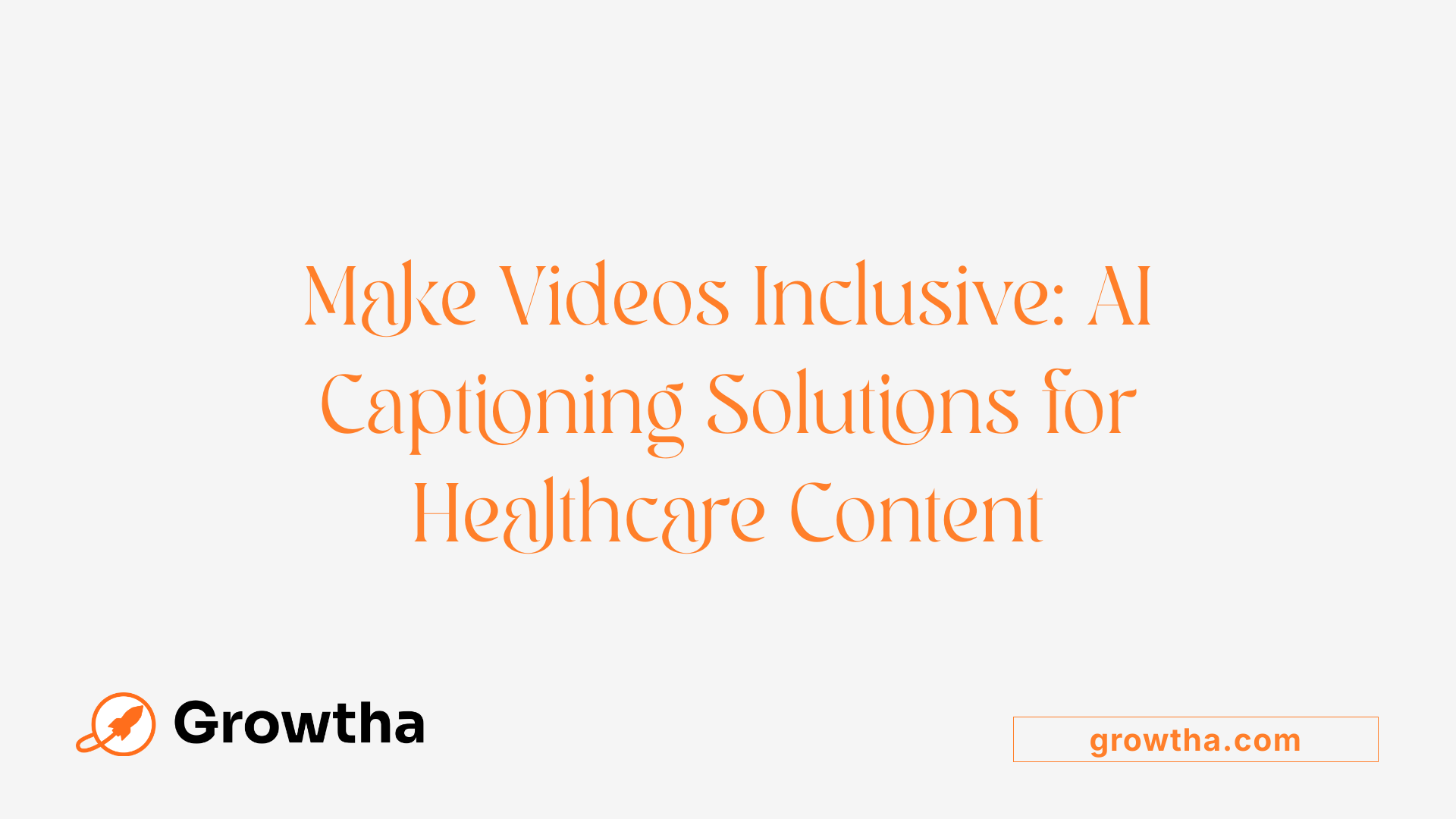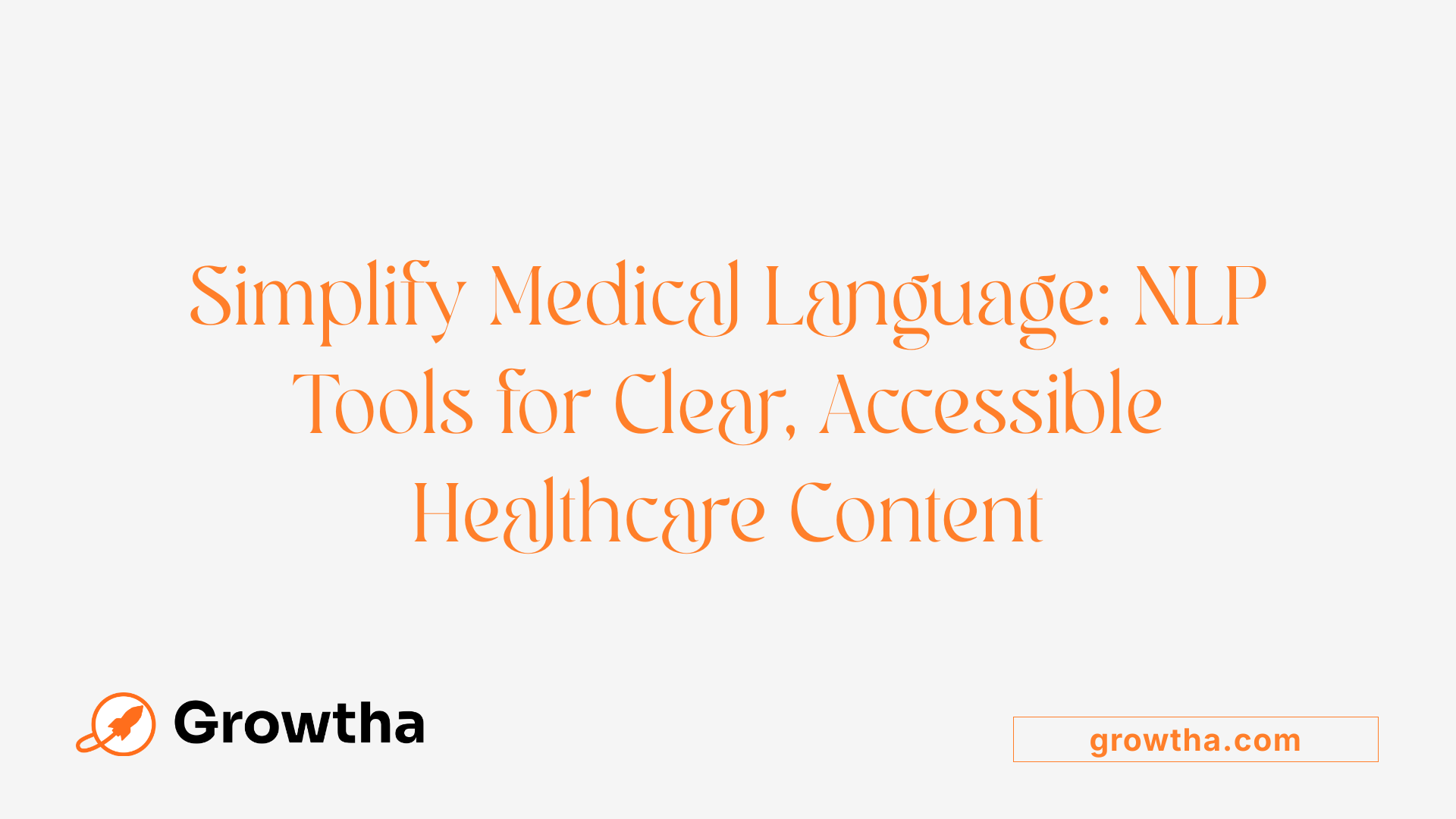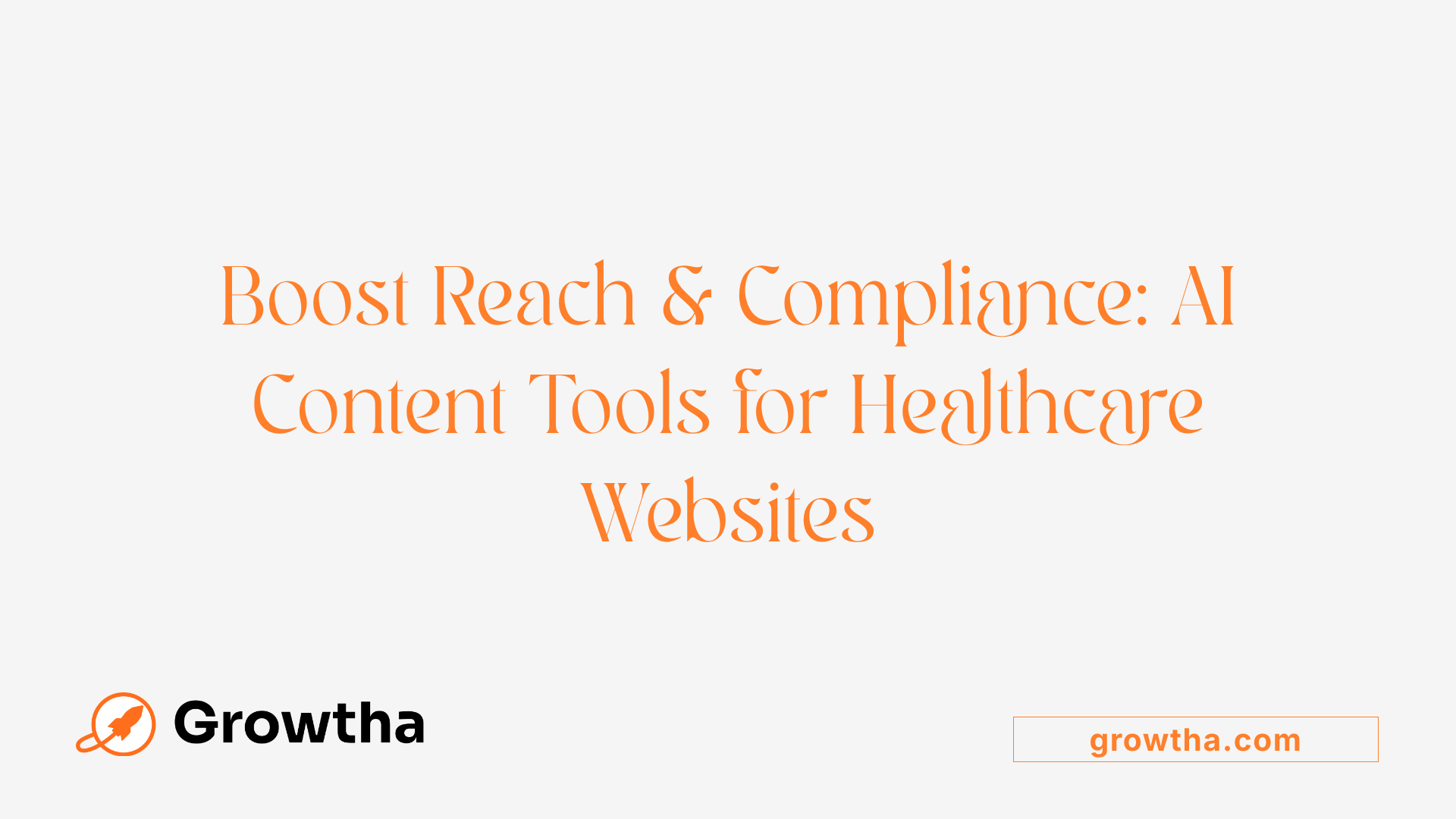ADA Compliance and SEO: What Healthcare Sites Need to Know
Enhancing Healthcare Accessibility and Visibility


ADA Compliance and SEO: What Healthcare Sites Need to Know
Unlocking the Intersection of ADA Compliance and SEO in Healthcare Websites
In today’s digital age, healthcare providers must prioritize both accessibility and search engine visibility. ADA compliance is not only a legal obligation but also a strategic advantage that improves user experience and boosts SEO rankings. This article explores how healthcare sites can leverage SEO content generators to meet ADA standards, enhance accessibility, and optimize their online presence effectively. We will delve into various tools and best practices that facilitate this integration, ensuring healthcare websites are inclusive, compliant, and highly discoverable.
Key Facts on Digital Accessibility for Healthcare Websites
- Automated alt text generators improve accessibility and SEO by creating descriptive texts for images.
- AI captioning tools automatically generate accurate captions and transcripts for videos, supporting users with hearing impairments.
- Natural Language Processing (NLP) simplifies complex medical language, making healthcare information more understandable and SEO-friendly.
- AI-powered accessibility checkers monitor ongoing website compliance by detecting barriers like missing alt texts and contrast issues.
- Content optimization tools help align healthcare websites with ADA standards while enhancing search engine rankings.
- Semantic HTML tags define clear webpage structure, improving screen reader navigation and overall accessibility.
- Structured data enhances search engine understanding of healthcare content, enabling rich snippets and better indexing.
- AI-driven link building automates the creation of descriptive link texts, supporting both usability and SEO.
- Real-time AI feedback systems continuously monitor accessibility, enabling swift fixes to maintain ongoing ADA compliance.
- ADA compliance in healthcare ensures full and equal access for disabled individuals, covering physical modifications and digital accessibility.
1. Automated Alt Text Generators for Accessibility and SEO
 Automated alt text generators are powerful tools that assist healthcare websites in creating descriptive alternative texts for images. These tools analyze the content of an image and automatically generate text that accurately describes what is depicted, ensuring that users relying on screen readers receive meaningful information. Implementing such generators supports screen reader compatibility by making visual content accessible to those with visual impairments, thus promoting ADA compliance.
Automated alt text generators are powerful tools that assist healthcare websites in creating descriptive alternative texts for images. These tools analyze the content of an image and automatically generate text that accurately describes what is depicted, ensuring that users relying on screen readers receive meaningful information. Implementing such generators supports screen reader compatibility by making visual content accessible to those with visual impairments, thus promoting ADA compliance.
Moreover, using descriptive alt texts enhances content discoverability for search engines. Search engines index alt text, helping healthcare providers improve their SEO rankings and reach a broader audience. Well-crafted alt descriptions not only satisfy accessibility standards but also boost visibility and engagement.
For healthcare websites, integrating AI-powered alt text generators simplifies ongoing website maintenance, ensures consistent accessibility, and aligns with best practices for digital inclusivity. These solutions include options like AI alt text generator healthcare websites, which are increasingly popular among organizations aiming to meet legal requirements and improve user experience.
2. AI-Driven Captioning Tools Enhancing Video Accessibility
 AI-powered captioning tools are transforming how healthcare websites make video content accessible. These tools automatically generate accurate captions and transcripts, ensuring that videos reach users with hearing impairments without the need for manual transcription.
AI-powered captioning tools are transforming how healthcare websites make video content accessible. These tools automatically generate accurate captions and transcripts, ensuring that videos reach users with hearing impairments without the need for manual transcription.
Supporting hearing-impaired users is not only a legal obligation but also a moral one. AI captioning solutions provide real-time, synchronized captions that improve understanding and engagement, making health educational videos, webinars, and telehealth sessions more inclusive.
Beyond accessibility, these enriched multimedia contents also bolster SEO efforts. By adding descriptive captions and transcripts, healthcare websites enhance keyword relevance, making content easier for search engines to index.
What types of websites need to be ADA compliant? Any website that provides products and services to the public or on behalf of another organization needs to be ADA compliant. This includes healthcare platforms, educational sites, government portals, and retail sites. Ensuring accessibility is a legal requirement across sectors and sizes.
For more information, search for "AI captioning tools for healthcare videos" to explore innovative solutions that heighten accessibility and boost search rankings.
3. Natural Language Processing for Clear and Understandable Content
 Creating accessible, easy-to-understand content is essential for healthcare websites aiming to meet ADA standards. Natural Language Processing (NLP) tools can help streamline and simplify complex medical language, making information more digestible for users with varying literacy levels and cognitive abilities.
Creating accessible, easy-to-understand content is essential for healthcare websites aiming to meet ADA standards. Natural Language Processing (NLP) tools can help streamline and simplify complex medical language, making information more digestible for users with varying literacy levels and cognitive abilities.
Supporting people with cognitive impairments involves using plain language, short sentences, and clear instructions. NLP can assist in rewriting technical jargon into simpler terms and generating summaries or key points that highlight important information. This approach ensures that all users, regardless of mental or learning disabilities, can comprehend vital health information.
In addition, well-structured language benefits SEO. Search engines favor content that is clear, organized, and easy to read. Using descriptive headings, logical flow, and accessible language improves user engagement and helps search engines better interpret the content. Moreover, incorporating keywords naturally within accessible text enhances visibility without compromising readability.
Does ADA compliance affect SEO?
Yes, compliance with ADA standards can significantly influence search engine optimization. Many accessibility practices—such as employing descriptive alt text for images, structuring content with proper headings, and ensuring the overall readability of a site—align with SEO best practices. These measures make content more accessible to both users with disabilities and search engines.
However, superficial solutions like installing accessibility overlays or widgets do not automatically improve SEO. Such overlays often lack the depth needed for true ADA compliance and can sometimes interfere with search engine crawling. Genuine ADA adherence involves fixing inherent site issues—like poorly structured HTML, inaccessible forms, and inadequate keyboard navigation—thus providing a better user experience and improving search rankings.
Achieving effective ADA compliance and SEO requires ongoing efforts: regular accessibility audits, code improvements, user testing, and staff training. These steps ensure that the site remains both legally compliant and highly discoverable in search engine results.
In summary, embracing accessible language and structure benefits everyone. It not only fulfills legal obligations but also boosts online visibility. Through a proactive, holistic approach, healthcare websites can support diverse users while enhancing their SEO performance.
4. Interactive Accessibility Checkers Powered by AI
 Automated compliance testing plays a critical role in maintaining ADA standards for healthcare websites. These AI-powered tools scan digital content to identify potential barriers that could hinder accessibility for users with disabilities. For example, they can detect missing alt texts for images, insufficient color contrast, improper heading structures, and keyboard navigation issues.
Automated compliance testing plays a critical role in maintaining ADA standards for healthcare websites. These AI-powered tools scan digital content to identify potential barriers that could hinder accessibility for users with disabilities. For example, they can detect missing alt texts for images, insufficient color contrast, improper heading structures, and keyboard navigation issues.
By supporting ongoing ADA compliance, these checkers enable healthcare providers to regularly monitor their websites' accessibility status. They generate detailed reports with specific fixes, helping teams efficiently address issues without requiring extensive manual testing. This continuous process ensures that digital health services remain inclusive and compliant amidst evolving standards.
Some notable AI-driven accessibility tools include Accessibility Checker, Web Accessibility, and WAVE by WebAIM. Each offers unique features; for example, WAVE highlights problematic areas directly on web pages, while Accessibility Checker provides comprehensive audits with actionable recommendations.
Incorporating these AI solutions into routine website maintenance not only helps prevent legal risks but also improves overall patient experience. By proactively addressing barriers, healthcare organizations demonstrate their commitment to inclusive care and equitable access for all users.
What is ADA compliance in healthcare facilities? ADA compliance in healthcare facilities means that these organizations are required to prohibit discrimination and ensure full, equal access for people with disabilities. This includes making physical modifications such as accessible entrances, bathrooms, and medical equipment, as well as providing effective communication through auxiliary aids like sign language interpreters or large print materials. Healthcare providers must also adapt policies and procedures—such as scheduling or assistance—to accommodate patients' needs. Additionally, digital accessibility must be maintained for online health records, websites, and telehealth services. Overall, ADA compliance ensures that people with disabilities can access healthcare services comfortably, safely, and without discrimination.
5. Content Optimization Tools for better Reach and Compliance
 Creating optimized pages using AI tools can greatly enhance both accessibility and search engine performance. AI-driven content generators and editing platforms help ensure that healthcare websites meet the necessary standards by automatically generating descriptive meta descriptions, headings, and alt text that adhere to accessibility guidelines.
Creating optimized pages using AI tools can greatly enhance both accessibility and search engine performance. AI-driven content generators and editing platforms help ensure that healthcare websites meet the necessary standards by automatically generating descriptive meta descriptions, headings, and alt text that adhere to accessibility guidelines.
Ensuring proper content structure is vital for accessibility and SEO. Proper use of headings, clear labels, and logical page flow make content more perceivable and operable for users with disabilities while also helping search engines understand the site hierarchy. Implementing semantic HTML tags and organizing information into well-defined sections supports assistive technologies such as screen readers and enhances crawlability.
AI tools can also be employed to monitor and improve ADA compliance continually. Automated scanners like Accessibility Checker, Web Accessibility, and WAVE provide regular audits, detecting issues like improper contrast, missing alt text, or navigation problems. These tools help identify areas that need fixing, allowing for rapid remediation.
Combining AI content creation with compliance monitoring ensures that healthcare websites remain accessible and optimized for search engines. Regular updates driven by AI insights can adapt to evolving standards, maintaining legal adherence and improving overall user experience.
Does ADA compliance affect SEO?
Yes, ADA compliance can significantly impact SEO because many accessibility best practices—such as using descriptive alt text, proper heading structures, and ensuring site readability—also improve how search engines crawl and index websites. However, simply installing accessibility widgets or overlays is not enough for full ADA compliance and may not effectively improve SEO, as they often lack compatibility with assistive technologies and do not address core accessibility issues.
Achieving true ADA compliance requires comprehensive measures like conducting accessibility audits, fixing code-level issues, improving keyboard navigation, and following WCAG guidelines—these efforts collectively enhance both accessibility and search engine optimization. Moreover, legal cases have shown that superficial solutions are insufficient, and ongoing monitoring and user testing are essential to maintain compliance and SEO benefits.
Ultimately, a thorough, proactive approach to accessibility not only reduces legal risks but also promotes a better user experience, positively affecting search rankings.
6. Semantic HTML and Structured Data Generators for SEO and Accessibility
What is ADA compliance in healthcare facilities?
ADA compliance in healthcare facilities means that these organizations are required to prohibit discrimination and ensure full, equal access for people with disabilities. This includes making physical modifications such as accessible entrances, bathrooms, and medical equipment, as well as providing effective communication through auxiliary aids like sign language interpreters or large print materials.
Healthcare providers must also adapt policies and procedures—such as scheduling or assistance—to accommodate patients' needs. Additionally, digital accessibility must be maintained for online health records, websites, and telehealth services.
Overall, ADA compliance ensures that people with disabilities can access healthcare services comfortably, safely, and without discrimination.
Using semantic HTML tags
Semantic HTML tags, such as
For example, using
Implementing structured data for better indexing
Structured data, like schema markup, helps search engines understand the content of healthcare websites more effectively. Adding schema.org tags for medical conditions, providers, or services improves how pages are indexed and displayed in search results.
This structured data can create rich snippets, such as star ratings, appointment info, or accreditation badges, which attract more clicks and enhance user trust.
Improving accessibility through proper markup
Proper markup involves correctly labeling images with alt text, structuring forms with labels, and using headings hierarchically (
, , etc.). It also includes ensuring elements are accessible via keyboard, providing captions for videos, and avoiding the use of color alone to convey information.
By integrating semantic HTML and structured data, healthcare websites become more discoverable, understandable, and inclusive, meeting both SEO and ADA accessibility standards.
7. AI-Powered Link Building for Accessibility and SEO
What types of websites need to be ADA compliant?
Any website that provides products and services to the public or on behalf of another organization needs to be ADA compliant. This includes healthcare sites, government portals, educational platforms, e-commerce stores, and nonprofit pages. No matter the size, businesses and institutions that serve the public must ensure their sites are accessible.
Creating accessible hyperlinks and navigation menus
AI tools can help generate and optimize links to support accessibility. For example, AI can automatically create descriptive link texts that clearly tell users what to expect when they click, making navigation more intuitive for everyone.
Accessible navigation menus should be logical and consistent across pages. AI can analyze site structure and suggest improvements, such as ensuring that menus are fully operable via keyboard and screen readers, aligning with ADA standards.
Ensuring descriptive and clear link text
Descriptive links are essential for users relying on assistive technologies. AI-powered platforms can automatically check link texts and suggest more descriptive alternatives. Instead of vague phrases like "click here," AI ensures each link clearly states its destination or purpose, boosting both accessibility and SEO.
Supporting user journey and site architecture
AI supports the overall user experience by mapping out the site’s architecture, identifying potential barriers, and recommending improvements. Clear, accessible links guide users smoothly through their journey, whether they are booking an appointment, accessing health information, or filling out forms.
Integrating AI into link building not only enhances compliance with ADA but also boosts search engine rankings by creating a logical, user-friendly site structure that search engines love. Properly built links improve crawlability, ensure all users can navigate easily, and demonstrate your commitment to inclusivity.
8. Real-time Monitoring and Feedback Systems for Continuous Compliance
Implementing real-time accessibility feedback tools is an effective way to ensure ongoing ADA compliance. These tools allow users to report issues instantly, providing healthcare organizations with immediate insights into potential barriers faced by visitors with disabilities.
Using AI-driven solutions enhances this process by continuously monitoring website accessibility status. Advanced AI algorithms can scan the entire site for compliance issues, flagging broken links, poor contrast, missing alt texts, or navigation problems without manual intervention. This constant oversight helps maintain high standards and quickly address emerging concerns.
Engaging users in feedback not only improves compliance but fosters trust and inclusivity. Encouraging feedback through prompts or dedicated channels ensures that those with disabilities feel valued and heard. Regularly incorporating this user input allows healthcare providers to make iterative improvements, keeping their websites accessible and user-friendly.
Does ADA compliance affect SEO? Yes, ADA compliance can significantly impact SEO because many accessibility practices—such as descriptive alt text, clear headings, and readable content—also support better search engine rankings. Properly optimized sites are easier for bots to crawl and understand, which boosts visibility.
However, superficial fixes like accessibility overlays can mislead organizations into a false sense of compliance. These solutions often don’t meet all WCAG standards or support assistive technologies fully, thereby not solving underlying issues. Proper compliance involves comprehensive audits, fixing structural and coding errors, and designing with accessibility in mind.
To achieve and maintain both ADA compliance and SEO benefits, healthcare websites should integrate automated testing tools, conduct manual reviews, and involve users with disabilities in regular testing cycles. This proactive approach reduces legal risks, enhances user experience, and improves search rankings, creating a safer, more inclusive digital environment for all users.
What is ADA compliance in healthcare facilities?
What is ADA compliance in healthcare facilities?
ADA compliance in healthcare facilities means that these organizations are required to prohibit discrimination and ensure full, equal access for people with disabilities. This involves making physical modifications such as accessible entrances, bathrooms, parking spaces, and medical equipment designed for mobility and sensory impairments.
Beyond physical changes, healthcare providers must also adapt their policies and procedures. This includes offering auxiliary aids like sign language interpreters, large print materials, or translation services to bridge communication gaps.
Digital accessibility is equally crucial. Online health records, appointment scheduling platforms, websites, and telehealth services must be accessible to users with disabilities. This can include ensuring compatibility with screen readers, providing text descriptions for images, captions for videos, and designing intuitive navigation.
Overall, ADA compliance guarantees that people with disabilities can access healthcare services comfortably, safely, and without discrimination. It promotes inclusivity, enhances patient experience, and aligns healthcare operations with legal standards.
Implementing these modifications not only fulfills legal obligations but also broadens the reach of healthcare services to all community members, fostering health equity and trust across diverse patient populations.
What types of websites need to be ADA compliant?
What types of websites need to be ADA compliant?
Any website that offers products, services, or information to the public, especially those related to healthcare, must be accessible according to ADA standards. This includes a broad range of online platforms.
Public-facing websites of healthcare providers, hospitals, clinics, and related organizations are required to comply. These sites often provide vital health information, appointment scheduling, and patient education resources.
Online patient portals and telehealth platforms are also covered under ADA compliance. They enable patients to access personal health records, communicate with providers, and use other healthcare services digitally.
Educational and informational healthcare websites, such as those offering health guides, research updates, and wellness tips, must also be accessible. These resources serve diverse audiences, including individuals with disabilities.
In essence, any website that serves the public or functions on behalf of a healthcare organization needs to meet ADA accessibility standards. This ensures equal access for all users, regardless of disabilities.
Legal mandates vary by sector, but generally, organizations of any size are responsible for ensuring their websites are ADA compliant. Non-compliance can lead to legal actions, financial penalties, and reputational damage.
More info: To find out which healthcare websites are specifically required to adhere to ADA regulations, a quick search query such as "Which healthcare websites require ADA compliance" can provide current regulations and best practices.
Does ADA compliance affect SEO?
How accessibility features align with SEO best practices
Making a healthcare website ADA compliant involves implementing features like descriptive alt text, logical heading structures, and accessible navigation. These elements are also favored by search engines because they help search bots understand and index content more effectively. For instance, alt text improves image discoverability, and clear headings enhance content hierarchy, facilitating better search engine crawling.
Impact on search engine rankings
Websites optimized for accessibility tend to perform better in search rankings. Google and other search engines prioritize user experience, and accessible sites provide a smoother journey for all visitors, including those with disabilities. Proper use of semantic HTML, descriptive page titles, and accessible multimedia ensures content is perceivable, operable, and understandable—principles that align with SEO protocols. Consequently, healthcare providers that invest in ADA compliance often see improvements in their visibility and ranking.
Importance of continuous compliance and testing
Achieving ADA compliance is not a one-time task but an ongoing process. Regular testing using automated tools like WAVE, Accessibility Checker, or third-party solutions such as UserWay is vital to identify and resolve accessibility issues promptly. Manual reviews and involving users with disabilities in testing further enhance accuracy. Continuous updates ensure that accessibility standards meet evolving WCAG guidelines and legal requirements, ultimately sustaining SEO advantages and preventing costly legal issues. Staying proactive with audits and improvements fosters trust, inclusivity, and a higher search engine ranking for healthcare websites.
Implementation strategies for ADA compliance and SEO
How can using SEO content generators help identify and fix accessibility issues?
SEO content generators can play a crucial role in making healthcare websites more accessible. These tools analyze your website content and structure, highlighting areas where accessibility may be lacking—such as missing alt text, poor color contrast, or confusing navigation structures. By leveraging AI-driven suggestions, website administrators can quickly identify specific issues and implement corrections, ensuring content is perceivable, operable, and understandable to all users, including those with disabilities. This proactive approach not only improves compliance with ADA and WCAG standards but also enhances overall user experience.
How do automating audits and compliance checks with AI tools improve adherence?
Automated AI tools like UserWay, AccessiBe, or WAVE continually scan your website for accessibility issues. They provide real-time reports and remediation suggestions, allowing healthcare providers to maintain high compliance levels without extensive manual effort. Regular automated checks help catch new issues introduced during updates or content additions, ensuring ongoing adherence to standards like WCAG 2.1 AA. This consistency reduces legal risks, boosts SEO performance, and demonstrates a commitment to inclusivity.
Why should healthcare organizations create standardized, accessible content templates?
Standardized templates streamline the creation of accessible content across the entire website. These templates include pre-designed features like proper heading hierarchies, consistent use of alt text, high-contrast color schemes, and accessible form elements. By using such templates, content creators ensure each page and resource aligns with ADA and WCAG guidelines, reducing manual errors and increasing efficiency. Maintaining a library of accessible templates fosters a uniform user experience, supports SEO, and upholds the organization’s reputation for inclusivity.
| Strategy | Benefits | Tools/Examples |
|---|---|---|
| SEO content generators | Quick issue identification, improved accessibility | SEMrush, Yoast, GPT-based tools |
| Automating audits with AI | Continuous compliance monitoring, reduced effort | UserWay, WAVE, accessiB&e |
| Creating content templates | Consistency, efficiency, adherence to standards | Custom HTML/CSS templates, CMS plugins |
The role of semantic HTML and structured data in accessible healthcare websites
What is ADA compliance in healthcare facilities?
ADA compliance in healthcare facilities ensures that all services, both physical and digital, are accessible and non-discriminatory for people with disabilities. This includes physical modifications—such as ramps, accessible restrooms, and specialized medical equipment—and effective communication methods like sign language interpreters and large print materials.
Digitally, ADA compliance involves ensuring online health records, websites, patient portals, and telehealth platforms are fully accessible. This means making sure users can navigate, understand, and interact with digital content seamlessly, regardless of their disabilities.
Using semantic HTML tags for clarity and accessibility
Semantic HTML is fundamental for creating accessible healthcare websites. Using tags like <header>, <nav>, <main>, <article>, <section>, <aside>, and <footer> clearly defines the structure of a webpage. This helps assistive technologies, such as screen readers, interpret page content correctly, enabling users with disabilities to navigate efficiently.
For example, replacing generic <div> tags with semantic tags makes it easier for users to jump between sections, understand where they are on the page, and locate important content quickly. Proper heading tags (<h1> through <h6>) further organize information hierarchically, promoting clarity and better user experience.
Implementing structured data for better indexing and visibility
Structured data, typically in JSON-LD format, enhances how healthcare websites are understood by search engines. Implementing schemas such as MedicalOrganization, Physician, or PatientRecord helps search engines display rich snippets, improve search visibility, and provide more relevant search results.
For example, adding structured data for a healthcare provider’s address, specialties, and contact info helps users find accurate information quickly. It also supports features like voice search and virtual assistants, making healthcare services more accessible to diverse users.
Enhancing overall compliance with HTML generators
Many HTML generators and content management systems now include tools to automatically insert semantic tags and structured data snippets, ensuring compliance and accessibility are maintained throughout updates. These tools standardize code, reduce errors, and make it easier for healthcare providers to stay aligned with WCAG and ADA standards.
Regularly using such generators and validating the code with accessibility checkers ensures ongoing compliance. Keeping the HTML well-structured benefits not only legal adherence but also improves overall user engagement and trust in healthcare digital services.
AI-powered link building to improve accessibility, compliance, and SEO
What types of websites need to be ADA compliant?
Any website that provides products and services to the public or on behalf of another organization needs to be ADA compliant. This includes healthcare websites, government portals, retail sites, educational platforms, and more. Ensuring accessibility is a legal requirement for most public-facing websites, especially those operated by organizations of any size. Compliance helps prevent lawsuits, improves user experience, and aligns with federal regulations.
Creating accessible hyperlinks and site architecture
Designing a site with accessibility in mind starts with proper link creation and logical site structure. Use a clean, hierarchical architecture that makes it easy for users and search engines to navigate. Implement a sitemap and clear pathways, with accessible navigation menus that can be operated via keyboard. Proper use of headers, consistent layout, and descriptive link placement collectively enhance overall accessibility.
Using descriptive link text for better usability and SEO
Links should always include clear, descriptive text. Instead of generic phrases like "click here," use specific phrases such as "schedule a consultation" or "download patient forms." This improves user experience for people with disabilities who rely on screen readers, as well as making the links more meaningful for search engines. Alt text for linked images should also be detailed and contextually relevant.
Supporting clear navigation paths for users and search engines
Supporting transparent navigation is vital. Include visual cues like focus indicators, consistent menu placement, and accessible breadcrumbs. This helps users with disabilities move effortlessly through your website and ensures search engines can index your content effectively. Regular testing with accessibility tools, such as WAVE or Accessibility Checker, ensures navigation remains intuitive and compliant.
Final thoughts
Integrating AI-driven link building strategies can optimize these accessibility practices by automating the identification of non-compliant links, suggesting improvements, and maintaining an accessible site architecture. This not only boosts compliance but enhances SEO, leading to better visibility and user trust in healthcare and other sectors.
Continuous compliance and real-time user feedback using AI systems
Monitoring accessibility in real-time is a crucial aspect of maintaining ADA compliance for healthcare websites and digital platforms. Automated tools and AI-driven systems can continuously scan websites to identify accessibility issues such as poor contrast, missing alt text, or navigation barriers. These tools provide instant feedback, enabling quick fixes before issues impact users.
Using AI to gather user feedback enhances the understanding of actual user experiences. AI-powered chatbots and feedback forms can solicit input from users with disabilities, capturing their struggles and suggestions. This direct input helps developers refine website features, improve usability, and address specific accessibility concerns.
Ensuring persistent compliance involves adopting adaptive systems that learn and evolve over time. Machine learning algorithms can analyze ongoing performance data, adapt accessibility features, and update content to meet WCAG 2.1 AA standards automatically. Such systems reduce manual oversight, provide ongoing assurance, and ensure health information remains accessible as technologies and standards evolve.
In the healthcare context, it is vital to incorporate these AI solutions to uphold legal obligations while promoting inclusivity. These advanced approaches support a proactive compliance strategy, ensuring that digital health resources are accessible to all, including those with visual, auditory, mobility, or cognitive impairments.
Ensuring Accessibility and SEO Success in Healthcare
Integrating ADA compliance with SEO strategies is essential for healthcare websites aiming to serve all users effectively while maintaining legal adherence and boosting search engine rankings. Utilizing advanced SEO content generators, AI-powered accessibility tools, and best practices such as semantic HTML and structured data can significantly enhance website accessibility, user experience, and discoverability. Continuous monitoring, regular audits, and proactive content optimization are vital in staying compliant and competitive. By embracing these technological solutions and adhering to established standards like WCAG 2.1 AA, healthcare providers can foster inclusivity, mitigate legal risks, and achieve optimal visibility—ultimately delivering high-quality, accessible healthcare to everyone.
References
- ADA Compliant Websites: Essential for Healthcare
- ADA Compliance Best Practices for Healthcare Websites
- Do medical websites need to be ADA compliant? - Full Media
- ADA Compliance Checklist: 11 Steps for Websites - AudioEye
- ADA Compliance for Medical Practice Websites
- The ADA, SEO, and Web Accessibility - CMI Media Group
- Why ADA Compliance Matters for Healthcare Websites
- Why ADA Compliance Matters for Healthcare Websites - Practis







